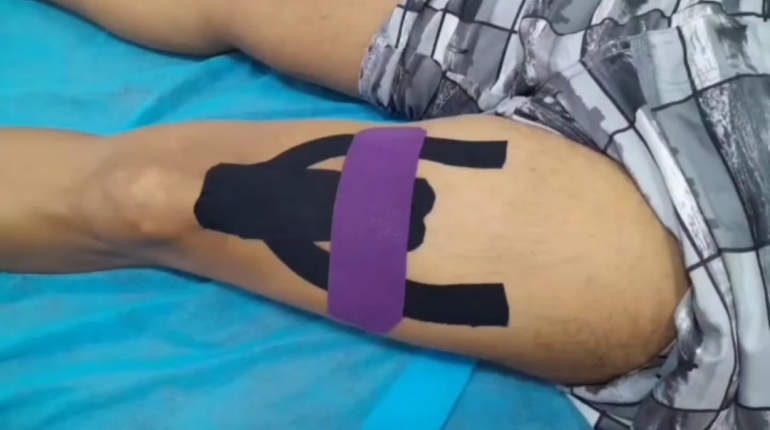Rigid And Kinesiology Taping
The Kinesio Taping® Method is a therapeutic taping technique which alleviates pain and facilitates lymphatic drainage by microscopically lifting the skin. This lifting affect forms convolutions in the skin increasing interstitial space and allowing for decreased inflammation in affected areas. Based upon research and years of clinical use, The Kinesio® Taping Method specifically applies Kinesio tape based on evaluation and assessment to dictate a specific application. Kinesio® Tex Tape applications can be applied in hundreds of ways and have the ability to reduce pain and inflammation, promote post-surgical healing, optimize performance, prevent injury and promote good circulation and can assist the body’s natural healing process.
Known for its ground breaking education for over 40 years Kinesio now introduces Kinesio Medical Taping. Kinesio University has all new Kinesio Medial Taping courses on how to apply Kinesio tape to the micro layers at the surface of the epidermis. Kinesio Medical Taping applications are designed by Dr Kenzo Kase® and are a whole new way to achieve optimal patient results. Kinesio Medical Taping is a future generation of treatment using Kinesio taping applications which can stimulate the epidermis at a cellular level.

Rigid taping
What is rigid taping?
The rigid taping technique is used to restrict movement by providing very firm support. In the acute stage of healing, support of ligament sprains, muscle strains, joint instability and inflammation is beneficial with this form of taping
Rigid taping is the most common technique and has been used for a very long time in sport. It is used primarily on joints such as ankles, knees, wrists, elbows and shoulders. The role of the tape is to physically support the joint by limiting movement. The tape is primarily used in returning to sport after a joint sprain, for example an ankle sprain. It provides support and stability that gives the athlete confidence within the joint. It is commonly used in rugby union/league, AFL and netball.

Taping is often chosen by our physiotherapists in the rehabilitation of many soft tissue injuries and movement dysfunctions.
General benefits of taping are:
- Provide support to soft tissues/joints/muscles
- Control joint instability
- Unload painful structures (muscle, tendon, ligament)
- Ease overworked muscles
- Assist pain management
- Develop posture awareness and body awareness
- Promote functional recovery
- Stimulate proprioceptive feedback
- Improve movement and performance in sport and daily activity There are different types of tape which can be divided into two categories. These are rigid tape or kinesiology tape.
What are the Benefits of Rigid Taping?
The type of tape required for rigid taping is a non-elastic tape. The rigid taping technique is used to restrict movement by providing very firm support. In the acute stage of healing, support of ligament sprains, muscle strains, joint instability and inflammation is beneficial with this form of taping. The firm taping allows for very controlled movement of the joint, soft tissue, trunk, pelvis or limb. When muscles are overworked, in pain and very tight, rigid taping can assist the muscles to rest and become less painful.
One example of joint instability and painful muscles in pregnancy that is commonly seen at Physiotherapy for Women is pregnancy related pelvic girdle pain. A specific rigid taping approach of the pelvis and sacroiliac joints can enable pregnant women to improve their walking by decreasing limping and pain.
Acute low back pain presenting with inflammation and trigger point tight spinal muscles will often benefit from rigid taping for 2-3 days. A pre-taping underwrap can be beneficial when skin is hypersensitive to the adhesive on the rigid tape.
What are the Benefits of Kinesiology Taping?
In kinesiology taping a thin, elasticised tape is used for many musculoskeletal injuries and physical dysfunctions that frequently present to a women’s health physiotherapy practice. The elastic properties of the tape on the skin promotes a bunching up action on the soft tissues immediately beneath the skin. This microscopic tissue lifting action can stimulate both lymphatic flow and blood flow, thereby reducing swelling, bruising and pain.
Kinesiology taping still provides support of injured tissues, but a certain amount of joint or muscle movement is allowed for. The amount of tension and direction of pull on the tissues is determined by the Physiotherapist.
A common presentation that benefits from kinesiology taping is correction of poor shoulder and shoulder blade posture, often seen with shoulder rotator cuff injury. The taping stimulates awareness by improving shoulder and shoulder blade movement in functional or sporting activities.
Knee pain when walking can often be helped with a directional tape that enhances patellar/knee cap tracking and supports knee structures. Kinesiology tape can become wet in a shower or when swimming. This tape can be left on for 3 to 5 days.
